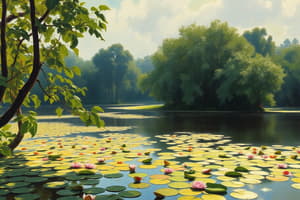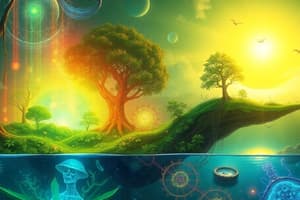Podcast
Questions and Answers
What process do kelp use to create food molecules?
What process do kelp use to create food molecules?
- Photosynthesis (correct)
- Fermentation
- Chemosynthesis
- Digestion
Which organelle is responsible for generating energy through cellular respiration in consumers?
Which organelle is responsible for generating energy through cellular respiration in consumers?
- Nucleus
- Mitochondria (correct)
- Chloroplast
- Ribosome
At which trophic level is the energy content the lowest in the marine ecosystem pyramid?
At which trophic level is the energy content the lowest in the marine ecosystem pyramid?
- Tertiary Consumers (correct)
- Secondary Consumers
- Producers
- Primary Consumers
Which chemical equation correctly represents cellular respiration?
Which chemical equation correctly represents cellular respiration?
What is the primary source of energy for the producers in the marine ecosystem?
What is the primary source of energy for the producers in the marine ecosystem?
Flashcards
Producers
Producers
Organisms that use sunlight to make their own food. They are the base of the food web.
Primary Consumers
Primary Consumers
Organisms that eat producers, obtaining energy from them. In a marine ecosystem, urchins are primary consumers.
Photosynthesis
Photosynthesis
The process by which plants and algae use sunlight to create their own food.
Cellular Respiration
Cellular Respiration
Signup and view all the flashcards
Chloroplasts
Chloroplasts
Signup and view all the flashcards
Study Notes
Energy Flow in an Ecosystem
- A pyramid depicts energy flow in an ecosystem.
- Producers (like kelp) are at the base, followed by primary consumers (like urchins), secondary consumers (like sea otters), and tertiary consumers (like orcas)
- Data shows the energy available at each trophic level. For example, 23,497,374 kcal of energy are available for the kelp
Photosynthesis
- Kelp use photosynthesis to make their own food.
- The process converts carbon dioxide and water to glucose during sunlight hours, with the release of oxygen (energy source).
- The chemical equation for photosynthesis is: carbon dioxide + water → glucose + oxygen
Cellular Respiration
- Animals like sea otters perform cellular respiration to break down food (glucose) for energy.
- The process uses oxygen and converts glucose back into carbon dioxide and water, releasing energy.
- The chemical equation for cellular respiration is: glucose + oxygen → carbon dioxide + water
Energy Transfer
- Energy is transferred between organisms.
- Organisms at each higher level consume those below.
- Energy is lost at each level as heat.
- For instance, orcas, as tertiary consumers, consume sea otters who consume urchins, and so on.
Organelles
- Chloroplasts are the organelles in plants (like kelp) responsible for photosynthesis.
- Mitochondria are the organelles in consumers (like animals) that perform cellular respiration.
Studying That Suits You
Use AI to generate personalized quizzes and flashcards to suit your learning preferences.




